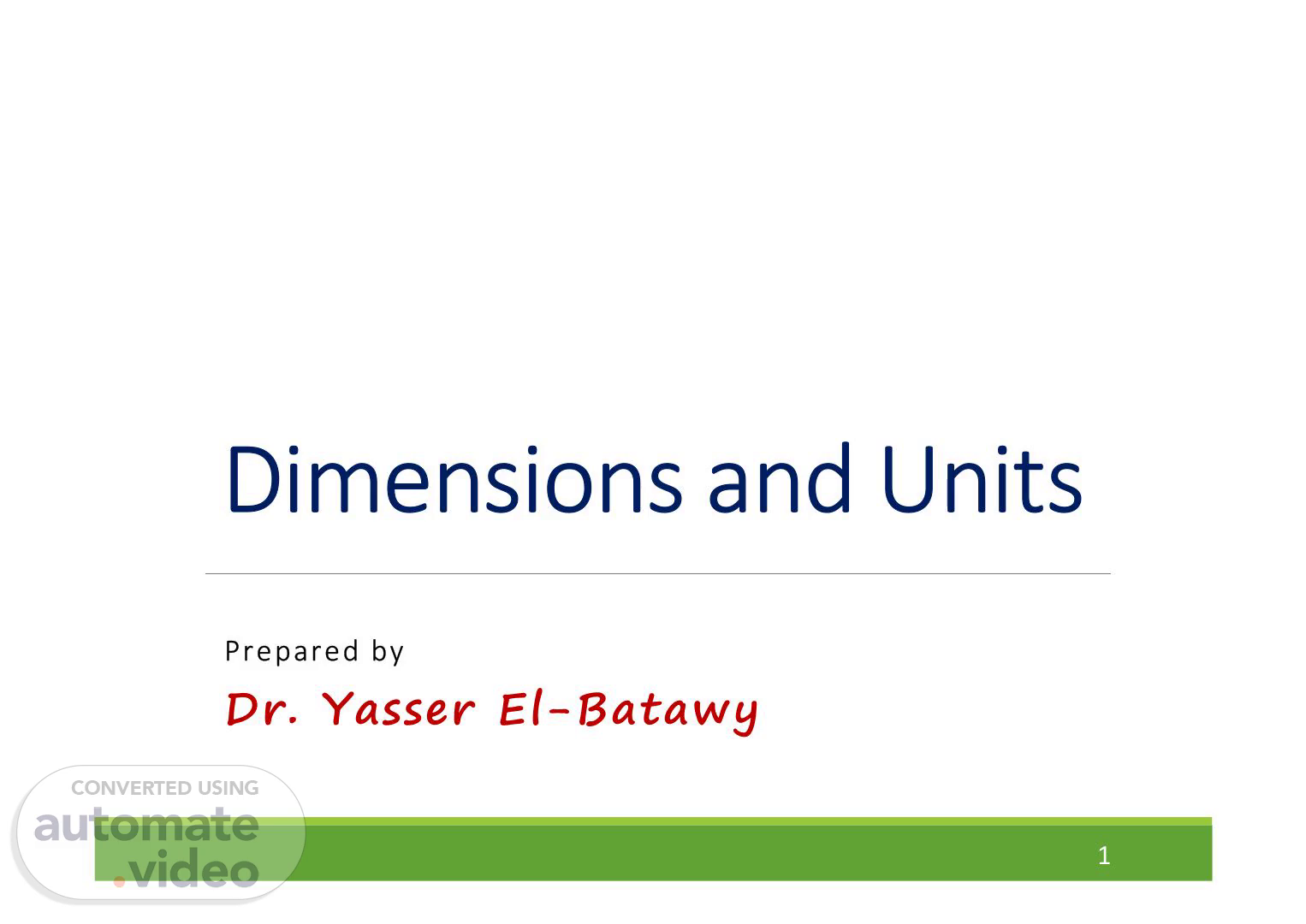Scene 1 (0s)
Dimensions and Units Prepared by Dr. Yasser El-Batawy 1.
Scene 2 (7s)
Measurements Used to describe natural phenomena Each measurement is associated with a physical quantity Need defined standards Characteristics of standards for measurements • Readily accessible • Possess some property that can be measured reliably • Must yield the same results when used by anyone anywhere • Cannot change with time 2.
Scene 3 (21s)
Basic Physical Quantities • There are certain basic physical quantities which are defined through the way they are measured. Such a procedure for defining the basic physical quantities is called operational procedure. • Other physical quantities are derived from the basic ones through the mathematical relations that relate them. • The choice of the basic quantities depends to some extent on the system of units used. • The most widely used system of units now is the SI “Système International”. 3.
Scene 4 (41s)
Fundamental Quantities and Their Units 4 Quantity SI Unit Length meter Mass kilogram Time second Temperature Kelvin Electric Current Ampere Luminous Intensity Candela Amount of Substance mole.
Scene 5 (49s)
Basic Quantities and Their Dimension Dimension has a specific meaning – it denotes the physical nature of a quantity. Dimensions are often denoted with square brackets. • Length [L] • Mass [M] • Time [T] 5.
Scene 6 (1m 0s)
Length Length is the distance between two points in space. Units • SI – meter, m Defined in terms of a meter – the distance traveled by light in a vacuum during a given time 6.
Scene 7 (1m 11s)
Mass Units • SI – kilogram, kg Defined in terms of a kilogram, based on a specific cylinder kept at the International Bureau of Standards Standard Kilogram 7.
Scene 8 (1m 21s)
Time Units • seconds, s Defined in terms of the oscillation of radiation from a cesium atom See Table 1.3 for some approximate time intervals. 8.
Scene 9 (1m 32s)
US Customary System Still used in the US, but text will use SI Quantity Unit Length foot Mass slug Time second 9.
Scene 10 (1m 40s)
I. Units and Dimensions of Physical Quantities Each dimension can have many actual units. Table 1.5 for the dimensions and units of some derived quantities 10.
Scene 11 (1m 51s)
Example 1: Determine the dimensions and SI units of the following physical quantities: • Force • Pressure • Potential Energy • Work • Power 11.
Scene 12 (2m 0s)
Solution : 12.
Scene 13 (2m 6s)
II. Units and Dimensions of Physical Constants Example 2: Newton’s law of universal gravitation is represented by � , where F is the gravitational force exerted by one small object on another, M and m are the masses of the objects, and r is a distance. What are the SI units of the Universal Gravitational constant “G” ? 13.
Scene 14 (2m 23s)
Solution : 14 � , then �.
Scene 15 (2m 29s)
Dimensional Analysis Technique to check the correctness of an equation or to assist in deriving an equation Dimensions (length, mass, time, combinations) can be treated as algebraic quantities. Both sides of equation must have the same dimensions. Any relationship can be correct only if the dimensions on both sides of the equation are the same. Cannot give numerical factors: this is its limitation 15.
Scene 16 (2m 49s)
III. Check of a Physical Relation Example 3: Is this equation correct velocity ? 16 Solution: Check the dimensions of the terms of the equation Dimensions of the terms are not equal Wrong.
Scene 17 (3m 0s)
Example 4: For the wave equation, , if x and y are distances, t is time, then, determine the dimensions of C1 , C2 , C3 and C4 17 Solution: L, T-1 , L-1 , Dimensionless.
Scene 18 (3m 14s)
IV. Building a Physical Relation bet. Dependent Parameters Dimensional Analysis can be used • to verify the validity of a certain equation from a dimensional point of view as in the previous example • to deduce the relationship between a certain physical quantity and the physical quantities it depends on. 18.
Scene 19 (3m 28s)
Example 5: Use dimensional analysis to derive the relationship between the time of small oscillations T of a simple pendulum and the length l of the pendulum and the acceleration of gravity g. 19.
Scene 20 (3m 39s)
Solution The relation between the periodic time T and other parameters can be written as 20 T Km l g K is a numerical constant The dimensions of the sides of the equation is 2 [ ] = [M] [ ] [ ] T L LT By Equating the powers of M, L, T over both sides 0= 0= 1= -2 .
Scene 21 (3m 54s)
Solution (cont.) Then, 21 L T C g 1 1 =0 2 2 Then,.
Scene 22 (4m 3s)
22 https://www.youtube.com/watch?v=-q18cgk9_Bs.
